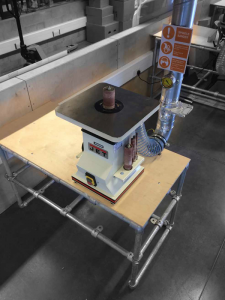- Spindle Sander
- Workshop Category: W3
- Workshop Risk Category: Yellow Label

The Spindle Sander is for surface or edge sanding of non-metallic materials only.
Start with a Risk Assessment to ensure a safe work area:
- The area around the Spindle Sander must be kept clear of people, debris and sawdust.
- Safety glasses or a face shield must be worn. Hearing protection should be worn.
- Remove loose fitting clothing, jewellery, and tie back long hair.
- Familiarise yourself with the off and on button.
- The abrasive sleeve will cut material very quickly, failure to anticipate this may cause injury to the finger and hands.
- The dust collector must be connected to the unit and gate open. The air flow must not be less than 1500 Pa.
- Check the integrity of the sleeves. Any ripped sleeves must be reported to the workshop manager.
- Do not wear gloves while operating the sander.
Operational Safety Rules:
- Approach your work in the workshop and on the spindle sander with a safe attitude.
- Ensure that the gap between the sanders table and the moving disc is kept as small as possible but does not restricted the disc turning.
- The distance between your fingertips and the moving disc or belt shall be no closer than 8cm.
- Do not sand pieces of material that are too small to be safely supported.
- Always hold the work firmly when sanding.
- Use the fence, table or other supports when sanding.
- Always hold the work firmly, the machine sands by turning clockwise at the same time as moving up and down.
- Avoid inappropriate hand positions where a sudden slip could cause a hand to move into the sanding disc.
- Do not sand with the work piece unsupported. Support the work piece with the table.
- Always remove scrap pieces and other objects from the table before turning the machine on.
- Allow the machine to reach full speed before feeding material. Similarly, it takes time for the spindle to stop moving.
- Do not push hard on the sanding media. The sander performs best and safest when it is allowed to remove material at the rate for which it was designed.
- Sanding wood or plastic will cause heat build-up due to friction and may cause the wood to burn and the plastic to melt rapidly.
- Never make adjustments while the sander is on.
- Always turn the machine off and disconnect the power cord before installing or removing the spindles.
- Never leave the machine work area when the machine is running or before the machine has come to a complete stop.
- Shut off power, clean the sander and work area before leaving the area.


